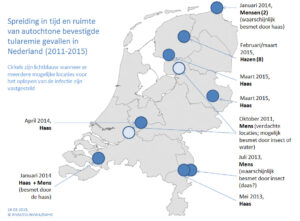Update: Tularemia in Friesland and Overijssel
In the last few weeks vets, farmers and hunters in central Friesland have reported a high rate of death among wild hares in the area. To date, the bacterial disease tularemia, caused by Francisella tularensis, has been associated with the death of eight hares from the area surrounding the Friesian town of Akkrum. This number reflects only to the number of dead hares submitted to the Dutch Wildlife Health Centre (DWHC) for post-mortem exam; the actual number of infected animals and animals dying from the disease is likely to be much higher. It is not clear whether the ongoing mouse plague in Friesland could be playing a role in this outbreak of tularemia but this possibility is being investigated. Tularemia was also found in two dead hares submitted from South Friesland and Overijssel in areas where an increased rate of death amongst hares was also reported.
 In the Netherlands a tularemia study group has been set up with representatives from a range of wildlife and public health organisations including the RIVM, GGD, CVI, DWHC and NVWA. The group performs research and risk analyses and produces information for use by medical and veterinary professionals and at-risk groups such as hunters.
In the Netherlands a tularemia study group has been set up with representatives from a range of wildlife and public health organisations including the RIVM, GGD, CVI, DWHC and NVWA. The group performs research and risk analyses and produces information for use by medical and veterinary professionals and at-risk groups such as hunters.
© RIVM/CVI/NVWA/DWHC
Tularemia in people
Tularemia in humans is very rare. People can become infected via contact with animals (in particular hares and rodents) but the bacteria is not transmitted from person to person. The most common routes of infection include:
- Via the skin e.g. small wounds or insect bites
- Ingestion of insufficiently cooked infected meat; the bacteria can be killed by heating to at least 60°C.
- Consumption of contaminated surface water
Preventative measures
In the countryside protect yourself from biting insects with products or appropriate clothing. Gloves should always be worn when handling animal carcasses and wounds should be thoroughly disinfected and covered.
Reporting a dead hare
You can report finding one or more dead hares (or other animals) in the wild, via the submission form on our website. After submitting your form you will be contacted by the DWHC who will help to decide whether or not further investigation is necessary and will advise you on how to package the cadaver and arrange collection of the package from your home or place of work.
Further information
Further information about this condition in humans and animals is available on the website of the OIE.



